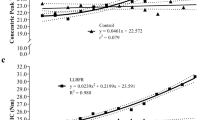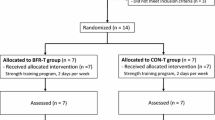Abstract
Purpose
We examined the concurrent characteristics of the remote development of strength and cross-sectional area (CSA) of upper body skeletal muscle in response to lower body resistance training performed with an applied blood flow restriction (BFR).
Methods
Males allocated to an experimental BFR group (EXP; n = 12) or a non-BFR control group (CON; n = 12) completed 7-weeks of resistance training comprising three sets of unilateral bicep curls [50% 1-repetition maximum (1-RM)], then four sets of bilateral knee extension and flexion exercises (30% 1-RM). EXP performed leg exercises with an applied BFR (60% limb occlusion pressure). 1-RM strength was measured using bilateral leg exercises and unilateral bicep curls in both trained and untrained arms. Muscle CSA was measured via peripheral quantitative computed tomography in the dominant leg and both arms.
Results
1-RM in the trained arm increased more in EXP (2.5 ± 0.4 kg; mean ± SEM) than the contralateral untrained arm (0.8 ± 0.4 kg), and the trained arm of CON (0.6 ± 0.3 kg, P < 0.05). The increase in knee extension 1-RM was twofold that of CON (P < 0.01). Knee flexion 1-RM, leg CSA, and trained arm CSA increased similarly between groups (P > 0.05), while untrained arm CSA did not change (P > 0.05).
Conclusion
Lower limb BFR training increased trained arm strength more than the contralateral untrained arm, and the trained arm of controls. However, there was no additional effect on muscle CSA. These findings support evidence for a BFR training-derived remote strength transfer that may be relevant to populations with localised movement disorders.





Similar content being viewed by others
Abbreviations
- 1-RM:
-
One-repetition maximum
- 4w:
-
Week 4 of the training programme
- 8w:
-
Week 8 of the training programme
- ACSM:
-
American College of Sports Medicine
- ANOVA:
-
Analysis of variance
- BFR:
-
Blood flow restriction
- BMI:
-
Body mass index
- CON:
-
Non-blood flow restriction training group
- CON-T:
-
Trained arm of non-blood flow restriction training group
- CON-U:
-
Untrained arm of non-blood flow restriction training group
- CSA:
-
Cross-sectional area
- EXP:
-
Blood flow restriction resistance training group
- EXP-T:
-
Trained arm of blood flow restriction resistance training group
- EXP-U:
-
Untrained arm of blood flow restriction resistance training group
- LOP:
-
Limb occlusion pressure
- pQCT:
-
Peripheral quantitative computed tomography
References
Abe T, Yasuda T, Midorikawa T, Sato Y, Kearns CF, Inoue K, Koizumi K, Ishii N (2005) Skeletal muscle size and circulating IGF-1 are increased after two weeks of twice daily “KAATSU” resistance training. Int J Kaatsu Train Res 1(1):6–12. https://doi.org/10.3806/ijktr.1.6
Abe T, Kearns CF, Sato Y (2006) Muscle size and strength are increased following walk training with restricted venous blood flow from the leg muscle, Kaatsu-walk training. J Appl Physiol 100(5):1460–1466. https://doi.org/10.1152/japplphysiol.01267.2005
Brandner CR, Kidgell DJ, Warmington SA (2015a) Unilateral bicep curl hemodynamics: low-pressure continuous vs high-pressure intermittent blood flow restriction. Scand J Med Sci Sports 25(6):770–777. https://doi.org/10.1111/sms.12297
Brandner CR, Warmington SA, Kidgell DJ (2015b) Corticomotor excitability is increased following an acute bout of blood flow restriction resistance exercise. Front Hum Neurosci 9:652. https://doi.org/10.3389/fnhum.2015.00652
Carolan B, Cafarelli E (1992) Adaptations in coactivation after isometric resistance training. J Appl Physiol 73(3):911–917
Coupaud S, Jack LP, Hunt KJ, Allan DB (2009) Muscle and bone adaptations after treadmill training in incomplete spinal cord injury: a case study using peripheral quantitative computed tomography. J Musculoskel Neuron 9(4):288–297
Doube M, Klosowski MM, Arganda-Carreras I, Cordelieres FP, Dougherty RP, Jackson JS, Schmid B, Hutchinson JR, Shefelbine SJ (2010) BoneJ: free and extensible bone image analysis in ImageJ. Bone 47(6):1076–1079. https://doi.org/10.1016/j.bone.2010.08.023
Fahs CA, Loenneke JP, Thiebaud RS, Rossow LM, Kim D, Abe T, Beck TW, Feeback DL, Bemben DA, Bemben MG (2015) Muscular adaptations to fatiguing exercise with and without blood flow restriction. Clin Physiol Funct Imaging 35(3):167–176. https://doi.org/10.1111/cpf.12141
Folland JP, Williams AG (2007) The adaptations to strength training: morphological and neurological contributions to increased strength. Sports Med 37(2):145–168
Fujita S, Abe T, Drummond MJ, Cadenas JG, Dreyer HC, Sato Y, Volpi E, Rasmussen BB (2007) Blood flow restriction during low-intensity resistance exercise increases S6K1 phosphorylation and muscle protein synthesis. J Appl Physiol 103(3):903–910. https://doi.org/10.1152/japplphysiol.00195.2007
Häkkinen K, Komi PV (1986) Training-induced changes in neuromuscular performance under voluntary and reflex conditions. Eur J Appl Physiol Occup Physiol 55(2):147–155. https://doi.org/10.1007/bf00714997
Häkkinen K, Alen M, Komi PV (1985) Changes in isometric force- and relaxation-time, electromyographic and muscle fibre characteristics of human skeletal muscle during strength training and detraining. Acta Physiol Scand 125(4):573–585. https://doi.org/10.1111/j.1748-1716.1985.tb07760.x
Hansen S, Kvorning T, Kjaer M, Sjogaard G (2001) The effect of short-term strength training on human skeletal muscle: the importance of physiologically elevated hormone levels. Scand J Med Sci Sports 11(6):347–354. https://doi.org/10.1034/j.1600-0838.2001.110606.x
Housh DJ, Housh TJ, Johnson GO, Chu WK (1992) Hypertrophic response to unilateral concentric isokinetic resistance training. J Appl Physiol 73(1):65–70
Kamke MR, Nydam AS, Sale MV, Mattingley JB (2016) Associative plasticity in the human motor cortex is enhanced by concurrently targeting separate muscle representations with excitatory and inhibitory protocols. J Neurophysiol 115(4):2191–2198. https://doi.org/10.1152/jn.00794.2015
Karabulut M, Abe T, Sato Y, Bemben M (2010) The effects of low-intensity resistance training with vascular restriction on leg muscle strength in older men. Eur J Appl Physiol 108(1):147–155. https://doi.org/10.1007/s00421-009-1204-5
Kim SJ, Sherk VD, Bemben MG, Bemben DA (2009) Effects of short-term, low-intensity resistance training with vascular restriction on arterial compliance in untrained young men. Int J Kaatsu Train Res 5(1):1–8
Kubo K, Komuro T, Ishiguro N, Tsunoda N, Sato Y, Ishii N, Kanehisa H, Fukunaga T (2006) Effects of low-load resistance training with vascular occlusion on the mechanical properties of muscle and tendon. J Appl Biomech 22(2):112–119
Lee M, Carroll TJ (2007) Cross education: possible mechanisms for the contralateral effects of unilateral resistance training. Sports Med 37(1):1–14. https://doi.org/10.2165/00007256-200737010-00001
Loenneke JP, Thiebaud RS, Fahs CA, Rossow LM, Abe T, Bemben MG (2013) Blood flow restriction does not result in prolonged decrements in torque. Eur J Appl Physiol 113(4):923–931
Madarame H, Neya M, Ochi E, Nakazato K, Sato Y, Ishii N (2008) Cross-transfer effects of resistance training with blood flow restriction. Med Sci Sports Exerc 40(2):258–263. https://doi.org/10.1249/mss.0b013e31815c6d7e
May AK, Brandner CR, Warmington SA (2017) Hemodynamic responses are reduced with aerobic compared with resistance blood flow restriction exercise. Physiol Rep 5 (3). https://doi.org/10.14814/phy2.13142
Moritani T, Sherman WM, Shibata M, Matsumoto T, Shinohara M (1992) Oxygen availability and motor unit activity in humans. Eur J Appl Physiol Occup Physiol 64(6):552–556. https://doi.org/10.1007/bf00843767
Moss BM, Refsnes PE, Abildgaard A, Nicolaysen K, Jensen J (1997) Effects of maximal effort strength training with different loads on dynamic strength, cross-sectional area, load-power and load-velocity relationships. Eur J Appl Physiol Occup Physiol 75(3):193–199. https://doi.org/10.1007/s004210050147
Munn J, Herbert RD, Gandevia SC (2004) Contralateral effects of unilateral resistance training: a meta-analysis. J Appl Physiol 96(5):1861–1866. https://doi.org/10.1152/japplphysiol.00541.2003
Narici MV, Roi GS, Landoni L, Minetti AE, Cerretelli P (1989) Changes in force, cross-sectional area and neural activation during strength training and detraining of the human quadriceps. Eur J Appl Physiol Occup Physiol 59(4):310–319
Narici MV, Hoppeler H, Kayser B, Landoni L, Claassen H, Gavardi C, Conti M, Cerretelli P (1996) Human quadriceps cross-sectional area, torque and neural activation during 6 months strength training. Acta Physiol Scand 157(2):175–186
Phillips SM (2012) Strength and hypertrophy with resistance training: chasing a hormonal ghost. Eur J Appl Physiol 112(5):1981–1983
Ploutz-Snyder LL, Giamis EL (2001) Orientation and familiarization to 1RM strength testing in old and young women. J Strength Cond Res 15(4):519–523
Rantalainen T, Duckham RL, Suominen H, Heinonen A, Alen M, Korhonen MT (2014) Tibial and fibular mid-shaft bone traits in young and older sprinters and non-athletic men. Calcif Tissue Int 95(2):132–140. https://doi.org/10.1007/s00223-014-9881-4
Rønnestad BR, Nygaard H, Raastad T (2011) Physiological elevation of endogenous hormones results in superior strength training adaptation. Eur J Appl Physiol 111(9):2249–2259. https://doi.org/10.1007/s00421-011-1860-0
Rutherford OM, Jones DA (1986) The role of learning and coordination in strength training. Eur J Appl Physiol Occup Physiol 55(1):100–105
Sale DG (1988) Neural adaptations to resistance training. Med Sci Sports Exerc 20(5):S135-S145
Schenk J, Forward E (1965) Quantitative strength changes with test repetitions. J Am Phys Ther Assoc 45:562–569
Scripture E, Smith TL, Brown EM (1894) On the education of muscular control and power. Stud Yale Psychol Lab 2:114–119
Seynnes OR, de Boer M, Narici MV (2007) Early skeletal muscle hypertrophy and architectural changes in response to high-intensity resistance training. J Appl Physiol 102(1):368–373. https://doi.org/10.1152/japplphysiol.00789.2006
Shepstone TN, Tang JE, Dallaire S, Schuenke MD, Staron RS, Phillips SM (2005) Short-term high- vs. low-velocity isokinetic lengthening training results in greater hypertrophy of the elbow flexors in young men. J Appl Physiol 98(5):1768–1776. https://doi.org/10.1152/japplphysiol.01027.2004
Staunton CA, May AK, Brandner CR, Warmington SA (2015) Haemodynamics of aerobic and resistance blood flow restriction exercise in young and older adults. Eur J Appl Physiol 115(11):2293–2302. https://doi.org/10.1007/s00421-015-3213-x
Suga T, Okita K, Morita N, Yokota T, Hirabayashi K, Horiuchi M, Takada S, Takahashi T, Omokawa M, Kinugawa S, Tsutsui H (2009) Intramuscular metabolism during low-intensity resistance exercise with blood flow restriction. J Appl Physiol 106(4):1119–1124
Takano H, Morita T, Iida H, Asada K, Kato M, Uno K, Hirose K, Matsumoto A, Takenaka K, Hirata Y, Eto F, Nagai R, Sato Y, Nakajima T (2005) Hemodynamic and hormonal responses to a short-term low-intensity resistance exercise with the reduction of muscle blood flow. Eur J Appl Physiol 95(1):65–73. https://doi.org/10.1007/s00421-005-1389-1
Takarada Y, Nakamura Y, Aruga S, Onda T, Miyazaki S, Ishii N (2000) Rapid increase in plasma growth hormone after low-intensity resistance exercise with vascular occlusion. J Appl Physiol 88(1):61–65
Tesch PA (1988) Skeletal muscle adaptations consequent to long-term heavy resistance exercise. Med Sci Sports Exerc 20(5 Suppl):S132–S134
Thompson W, Gordon N, Pescatello L (2010) ACSM’s guidelines for exercise testing and prescription, 8th edn. Lippincott Williams & Wilkins, Philadelphia
Walker KS, Kambadur R, Sharma M, Smith HK (2004) Resistance training alters plasma myostatin but not IGF-1 in healthy men. Med Sci Sports Exerc 36(5):787–793
West DW, Burd NA, Tang JE, Moore DR, Staples AW, Holwerda AM, Baker SK, Phillips SM (2010) Elevations in ostensibly anabolic hormones with resistance exercise enhance neither training-induced muscle hypertrophy nor strength of the elbow flexors. J Appl Physiol 108(1):60–67. https://doi.org/10.1152/japplphysiol.01147.2009
Yasuda T, Ogasawara R, Sakamaki M, Ozaki H, Sato Y, Abe T (2011) Combined effects of low-intensity blood flow restriction training and high-intensity resistance training on muscle strength and size. Eur J Appl Physiol 111(10):2525–2533. https://doi.org/10.1007/s00421-011-1873-8
Young A, Stokes M, Round JM, Edwards RH (1983) The effect of high-resistance training on the strength and cross-sectional area of the human quadriceps. Eur J Clin Invest 13(5):411–417
Funding
This research was supported only by local funds made available by the School of Exercise and Nutrition Sciences, Faculty of Health, Deakin University, Victoria, Australia.
Author information
Authors and Affiliations
Contributions
All authors conceived and designed research. AM conducted experiments. AM and SW analysed data. All authors wrote, edited, and approved the manuscript.
Corresponding author
Ethics declarations
Conflict of interest
The authors declare no conflict of interest.
Research involving human participants
All procedures performed in this study involving human participants were in accordance with the ethical standards of the institutional and/or national research committee and with the 1964 Helsinki declaration and its later amendments or comparable ethical standards.
Additional information
Communicated by Anni Vanhatalo.
Rights and permissions
About this article
Cite this article
May, A.K., Russell, A.P. & Warmington, S.A. Lower body blood flow restriction training may induce remote muscle strength adaptations in an active unrestricted arm. Eur J Appl Physiol 118, 617–627 (2018). https://doi.org/10.1007/s00421-018-3806-2
Received:
Accepted:
Published:
Issue Date:
DOI: https://doi.org/10.1007/s00421-018-3806-2




